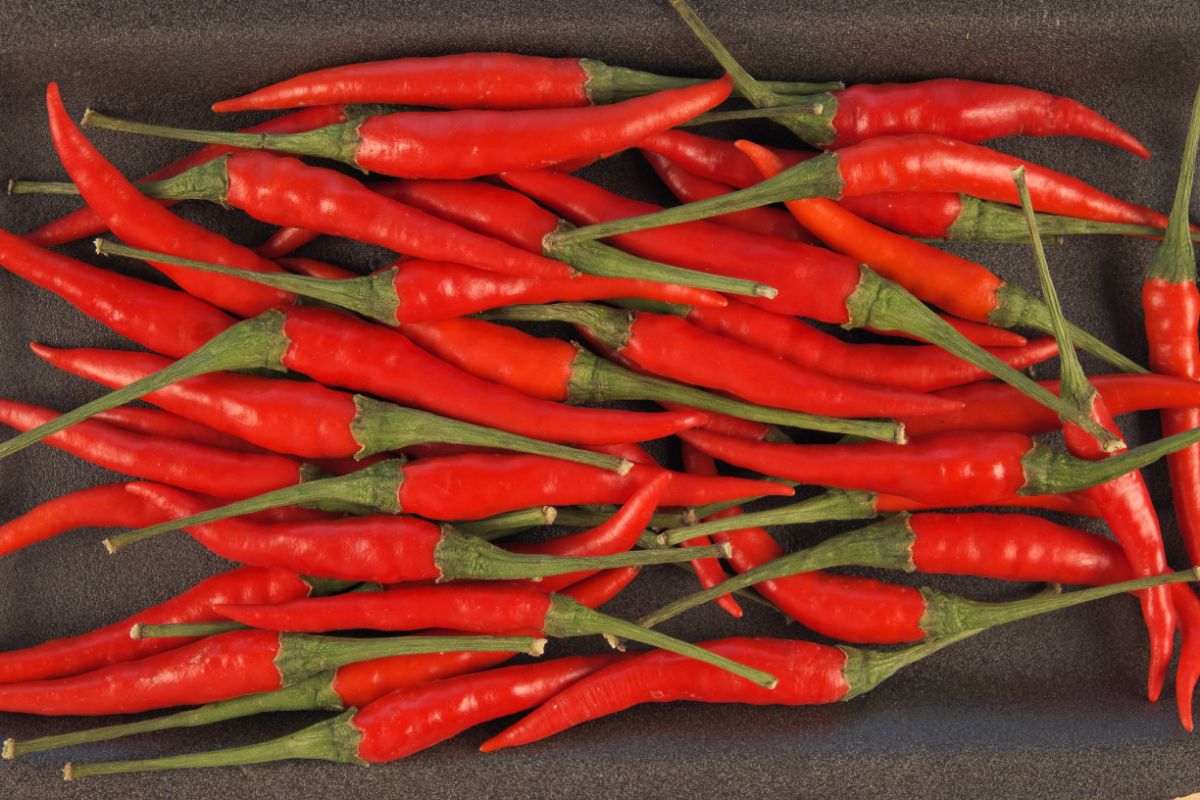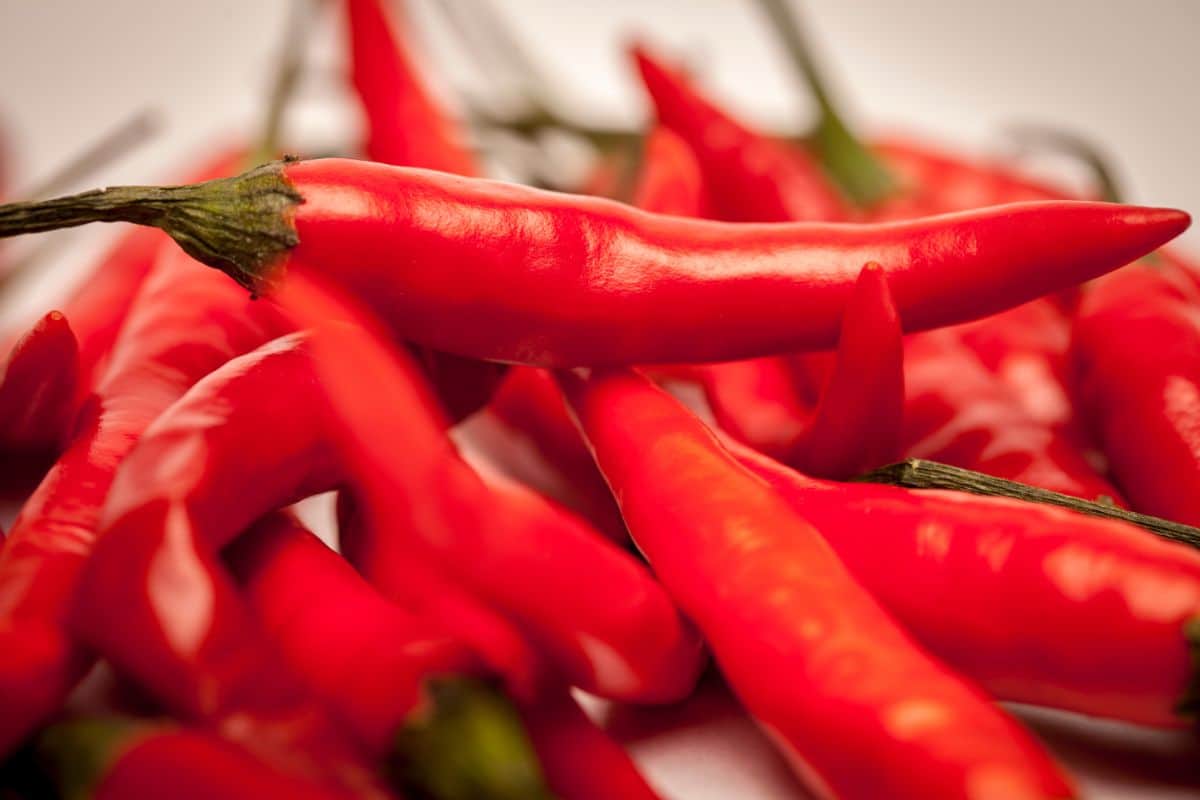For centuries, peppers have been an essential ingredient in cuisines all across the world. From mild bell peppers to the fiery habanero, there is a pepper for every palate.

But if you’re looking to add some serious heat and flavor to your cooking, you can’t go wrong with Thai peppers.
Thai peppers are a staple in Thai cuisine, known for their intense heat and fruity, almost citrus-like flavor.
Thai peppers aren’t just hot – they’re also incredibly versatile. They can be used in everything from curries and stir-fries to salads and marinades.
And if you’re a fan of spicy food, you’ll find that Thai peppers are the perfect way to add heat without overpowering other flavors.
In this guide, we’ll take a closer look at Thai peppers and everything you need to know about these amazing little peppers.
We’ll explore their history and origins, their nutritional benefits, and the various ways they might be used in cooking.
Whether you’re a seasoned cook looking to add some spice to your dishes or a curious foodie looking to explore new flavors, this guide has everything you need to become a Thai pepper expert.
So let’s dive in and discover the wonderful world of Thai peppers!
What Are Thai Peppers?
Thai peppers, which are also called bird’s eye chili peppers or Thai chili peppers, are a type of small, fiery hot pepper that originated in Thailand and are widely incorporated into Thai cuisine.
They are typically between 1 and 2 inches long and come in a range of colors, including green, red, and yellow.
Thai peppers are known for their intense heat, which can vary from 50,000 – 100,000 Scoville units, depending on the variety.
This makes them considerably hotter than the jalapeno pepper, which typically has a Scoville rating of only 2,500 to 8,000 units.
Despite their heat, Thai peppers have a unique flavor, which is described as fruity and almost citrus-like.
They are commonly used in Thai curries, stir-fries, soups, and salads, as well as in marinades and sauces.
They are also an excellent source of vitamin C, vitamin A, and antioxidants, which can help boost the immune system and promote overall health.
They are also low in calories and fat, making them a healthy addition to many dishes.
Overall, Thai peppers are a versatile and flavorful ingredient that can add a spicy kick to any dish.
Whether you’re a fan of spicy food or simply looking to explore new flavors, Thai peppers are definitely worth trying.
History Of Thai Peppers
The history of Thai peppers can be traced back to Thailand, where they have been an important ingredient in Thai cuisine for centuries.
The pepper’s scientific name, Capsicum frutescens, suggests that it may have originated in Central or South America and was brought to Thailand by traders or explorers.
Thai peppers are believed to have been cultivated in Thailand since at least the 16th century, and they quickly became a popular ingredient in Thai cooking.
They were used not only for their fiery heat but also for their unique flavor, which complemented other ingredients in traditional Thai dishes.
Over time, Thai peppers spread beyond Thailand and became popular throughout Southeast Asia and other parts of the world.
Today, they are grown in many countries and used in a variety of cuisines, from Indian and Malaysian to Mexican and Caribbean.
In addition to their culinary uses, Thai peppers have also been used in traditional medicine for their potential health benefits.
They contain capsaicin, a compound that is believed to have anti-inflammatory and pain-relieving properties.
Thai peppers have been used to treat various ailments, including arthritis, headaches, and digestive issues.
Thai peppers have a rich history and have played an important role in Thai culture and cuisine for centuries.
Their popularity has only continued to grow over time, as people across the globe have discovered their unique flavor and powerful heat.
Types Of Thai Peppers
There are several types of Thai peppers, each with its own unique flavor and level of heat. Here are a few common types:
- Bird’s Eye Chili Pepper: Also called “prik kee noo,” this is the most common type of Thai pepper. It is small and thin, usually measuring about 1-2 inches long. Bird’s eye chili peppers are extremely spicy and have a bright, citrusy flavor.
- Thai Dragon Pepper: This pepper is slightly larger than the bird’s eye chili pepper and has a slightly sweeter taste. It is still quite hot, however, with a Scoville rating of around 50,000-100,000 units.
- Prik Chi Fah: This pepper is slightly larger than the bird’s eye chili pepper and has a slightly less intense heat. It is commonly used in Thai salads and stir-fries.
- Prik Num: This pepper is larger than the bird’s eye chili pepper and has a mild to medium level of heat. It is commonly used in Thai soups and curries.
- Prik Yuak: This pepper is also known as the yellow Thai pepper, and as its name suggests, it is yellow in color. It is very mild, with a sweet, slightly fruity flavor.
- Prik Chee Fah: This pepper is similar in size and heat to the bird’s eye chili pepper but is bright red in color. It is commonly used in Thai salads and curries.
Thai peppers come in a variety of sizes, colors, and heat levels, allowing cooks to choose the perfect pepper for their desired level of heat and flavor.
Thai Pepper Culinary Uses
Thai peppers are a staple ingredient in Thai food and are used in a wide variety of dishes. Here are some of the most common culinary uses of Thai peppers:
- Thai curries: Thai peppers are a key ingredient in many Thai curry recipes, adding heat and flavor to dishes like green curry, red curry, and panang curry.
- Stir-fries: Thai peppers are commonly used in stir-fry dishes, where they add a spicy kick to vegetables, meats, and noodles.
- Salads: Thai peppers are often used in Thai salads like som tum (green papaya salad) and larb (a meat or vegetable salad), adding a fiery heat to these fresh and flavorful dishes.
- Soups: Thai peppers are commonly used in soups like tom yum and tom kha gai, adding heat and depth of flavor to these classic Thai dishes.
- Marinades and sauces: Thai peppers can be used to make spicy marinades and sauces for meats, seafood, and vegetables, adding a complex, fiery flavor to these dishes.
It’s important to note that Thai peppers are very hot, so cooks should use them sparingly and with caution.
If you’re new to using Thai peppers, start with a small amount and gradually increase the amount until you reach your desired level of heat.
You can also remove the seeds and inner membranes of the peppers, which will reduce their heat level.
Thai Pepper Medicinal Uses
Thai peppers have been used for centuries in traditional medicine to treat various ailments, thanks to their potential health benefits.

Here are some of the medicinal uses of Thai peppers:
- Pain relief: Thai peppers contain capsaicin, a compound that has been shown to have pain-relieving properties.
Capsaicin works by binding to pain receptors in the body, reducing the amount of pain signals sent to the brain. Thai peppers may be used topically to relieve pain from conditions like arthritis, muscle pain, and headaches.
- Anti-inflammatory: Capsaicin has also been shown to have anti-inflammatory properties. Inflammation is a common underlying factor in many chronic diseases, so reducing inflammation can have wide-ranging health benefits.
Thai peppers may help to reduce inflammation and improve symptoms in conditions like rheumatoid arthritis and inflammatory bowel disease.
- Digestive health: Thai peppers are a rich source of dietary fiber, which is important for digestive health.
They may also have antimicrobial properties, which can help to promote a healthy balance of bacteria in the gut. Thai peppers may help to relieve digestive issues like constipation, diarrhea, and bloating.
- Cardiovascular health: Thai peppers contain antioxidants like vitamin C, which may help to reduce the risk of heart disease. They may also help to lower blood pressure and improve blood lipid levels, both of which are important for cardiovascular health.
It’s important to note that while Thai peppers may have potential health benefits, they should not be used as a substitute for medical treatment.
If you have a medical condition or are taking medication, talk to your healthcare provider before using Thai peppers for medicinal purposes.
How To Prepare Thai Peppers
Thai peppers are a versatile ingredient that can be incorporated into a variety of dishes. Here are some tips on how to prepare Thai peppers:
- Choose fresh, firm peppers: Look for Thai peppers that are firm and free from blemishes. Avoid peppers that are soft or wrinkled, as they may be past their prime.
- Wash the peppers: Rinse the peppers under cool water to remove any dirt or debris.
- Remove the stem: Use a sharp knife or scissors to cut off the stem of the pepper. Be careful not to touch the seeds or inner membrane, as they can be very hot and can irritate the skin.
- Remove the seeds and membrane (optional): If you prefer a milder flavor, you can remove the seeds and inner membrane of the pepper. Simply cut the pepper in half lengthwise and use a spoon or your fingers to scrape out the seeds and membrane.
- Slice or chop the peppers: Depending on the recipe, you may want to slice or chop the peppers into small pieces. Be sure to use a sharp knife and wash your hands thoroughly after handling the peppers, as the capsaicin in the peppers can irritate the skin and eyes.
- Cook or use raw: Thai peppers may be used in a variety of dishes, either cooked or raw. Add them to stir-fries, curries, soups, or salads for a spicy kick.
Remember to use Thai peppers sparingly, as they are very hot. Start with a small amount and adjust the quantity to your desired level of heat.
And be sure to wash your hands thoroughly after handling Thai peppers, to avoid getting capsaicin on your skin or in your eyes.
What Do Thai Peppers Taste Like?
Thai peppers are known for their intense heat and pungent flavor.
They have a fruity and slightly sweet taste, with a distinctive spiciness that can range from mild to very hot, depending on the variety and the amount used.
In addition to their heat, Thai peppers have a complex flavor profile, with hints of citrus and earthy undertones.
They also have a slightly floral aroma that is characteristic of many chili peppers.
It’s important to note that the heat level of Thai peppers can vary widely, depending on factors like the variety of pepper, the ripeness of the pepper, and the growing conditions.
Some Thai peppers are milder, while others can be extremely hot.
So when cooking with Thai peppers, it’s important to adjust the amount of peppers used to suit your taste preferences.
Where To Buy Thai Peppers
Thai peppers can be found in many grocery stores, specialty food stores, and Asian markets. Here are some tips on where to buy Thai peppers:
- Local grocery stores: Many grocery stores carry Thai peppers, especially those with a well-stocked produce section. Look for them in the ethnic foods section, or ask the store’s produce manager for assistance.
- Specialty food stores: Specialty food stores like Whole Foods or Trader Joe’s may carry Thai peppers, either fresh or dried. These stores often have a wider selection of ethnic foods and ingredients.
- Asian markets: Asian markets are a great place to find Thai peppers, as well as other specialty ingredients.
These markets often carry a wide variety of fresh produce, including hard-to-find ingredients like Thai eggplant and kaffir lime leaves.
- Online retailers: If you can’t find Thai peppers in your local stores, you may be able to purchase them online from retailers like Amazon or specialty food websites.
This can be a convenient option, especially if you live in a rural area or don’t have access to a wide variety of stores.
When buying Thai peppers, look for peppers that are firm, fresh, and free from blemishes. If you can, smell the peppers to check for freshness. And remember, the heat level of Thai peppers can vary widely, so start with a small amount and adjust to taste.
Final Thoughts
Thai peppers are an amazing ingredient that adds a unique flavor and heat to many dishes.
With their intense spiciness and complex flavor profile, they are an essential ingredient in Thai cuisine and are becoming increasingly popular in other parts of the world.
Not only do Thai peppers add flavor and heat to dishes, but they also have several potential health benefits.
They are rich in vitamins and minerals, and research suggests that the capsaicin in peppers may have anti-inflammatory and pain-relieving properties.
Additionally, some studies have linked capsaicin consumption to lower rates of certain cancers and improved cardiovascular health.
If you’re interested in using Thai peppers in your cooking, they can be found in many grocery stores, specialty food stores, and Asian markets.
When shopping for Thai peppers, look for peppers that are fresh, firm, and free from blemishes.
Whether you’re making a spicy curry, stir-fry, or salad, Thai peppers are sure to add a delicious and fiery kick to your dish.
And with their potential health benefits, there’s even more reason to incorporate them into your cooking. So why not give Thai peppers a try and add some heat and flavor to your next meal?






